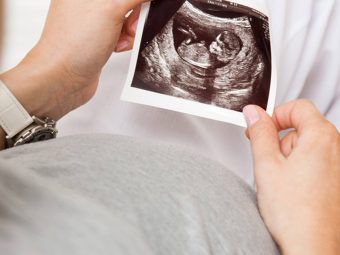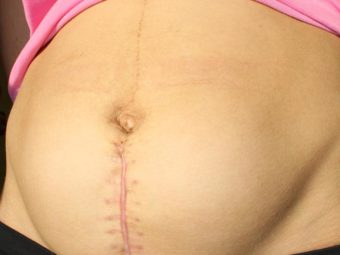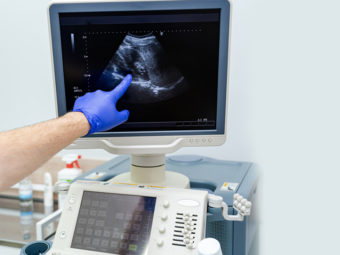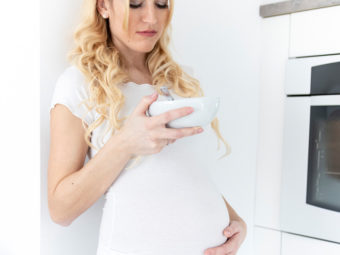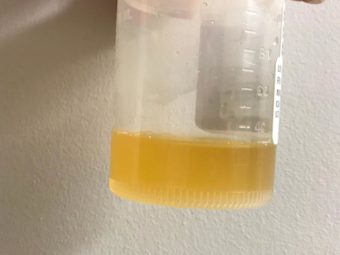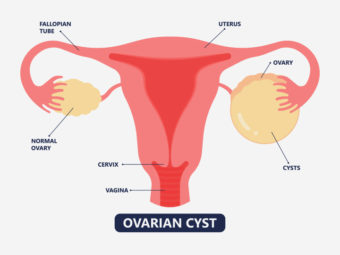
Image: MomJunction
Sacral dimples in newborns are characterized by shallow or deep indentations on the lower back (lower sacral region), just above the crease of the buttocks. They are a common cutaneous (relating to the skin) anomaly found duringneonataliXNewborn infant under four weeks old.spinal examinations. They are also known as sacrococcygeal or coccygeal dimples or pits.
According to studies, sacral dimples arebenigniXLikely not harmful.and require no medical intervention(1). They are found in1.8–7.2% of newbornsand are usually detected during routine examinations (2.). However, the exact cause of this congenital condition is unknown.
If the sacral dimples are large, located farther from the anus, or accompanied by a turf of hair, skin tag, or skin discoloration, they might be an indication of an underlying abnormality of the spinal cord. Hence, in such cases, consult your baby’s pediatrician to check if it is a cause for concern.
Read this post to learn about the reasons, types, and treatment options for sacral dimples in babies.
Types Of Sacral Dimples
Sacral dimples are of two types.
- Typical sacral dimples: These are located on theskin of the lower back,near the crease of the buttocks. Usually, you will notice no skin changes other than the shallow depression near the tailbone (coccyx) end.
 Quick fact
Quick fact- 非典型骶酒窝:这种类型的酒窝is located higher up on the back or off to the side, and the bottom of the dimple may not be seen. It may also be accompanied by skin discoloration, a patch of hair, a lump, or a skin tag(3).
Consult yourinfant’s pediatricianif you notice an atypical dimple on your baby’s body.
Symptoms Of Abnormal Sacral Dimples
Often, sacral dimples are benign and may not be a cause for concern. However, if you find the below symptoms, it could be due to an underlying medical condition(4).
- Sacral dimples accompanied by a patch of hair,a birthmark, a deviated buttock fold, or discharge
- Abnormal scan of the neonatal spinal column
Image: Shutterstock
- Weakness
- Loss of sensation
- Signs ofscoliosisiXAbnormal lateral curvature of the spine.
- Congenital dislocation of the hips
- Poor urine stream in boys
- PatulousiXExpanding from the center.anal opening
Possible Complications Of Sacral Dimples
Sacral dimples are associated with complications when they belong to the atypical type. These dimples usually indicate spinal cord issues. Some of the possible problems include(3)(5)
- Tethered spinal cord:In this condition, the spinal cord attaches to the tissue around the spine; thus, limiting themovement of the spinal cordwithin the spinal canal.
- Spina bifida:This is a mild condition wherein thespine doesn’t closearound the spinal cord completely and remains within the spinal canal.Spina bifidamay not cause any symptoms.
Image: Shutterstock
- Dermal sinus tract:This refers to anabnormal connectionbetween theskin and spine. It can lead to infection.
Diagnosis Of Sacral Dimples
Sacral dimples are usually identified during the routine neonatalphysical examination, and further investigations may not be required in the case of a typical sacral dimple.
However, if your doctor notices any abnormal skin changes or developmental defects near the sacrum or sacral dimple, they might recommend the following tests to rule out spinal cord problems.
Ultrasonography is considered a safe and cost-effective screening method for infants, as it is a noninvasive screening technique that does not have the risk of radiation(2).
Sometimes, your doctor may order anMRIiXA non-invasive imaging technology used for the detection, diagnosis, and monitoring of a disease.for the neonate or infant.
Treatment For Sacral Dimples
No specific treatment is needed if the sacral dimple is typical. However, the dimple or pit may collect dirt and sweat, which may increase the risk of an infection. So, try to keep the dimple area clean andavoid fecal matterfrom getting into it.
If your infant’s doctor diagnoses anatypical sacral dimple, they might prescribe the necessary treatment.
 Quick fact
Quick factFrequently Asked Questions
1. Are sacral dimples hereditary?
Some inconclusive medical research suggests a genetic predisposal to sacral dimples. However, more research may be needed to prove this theory (6).
2. What does an ultrasound of a sacral dimple look for?
An ultrasound is done to check for any communication between the sacral dimple and the spinal canal/vertebral column (7).
3. Do sacral dimples go away?
A sacral dimple does not go away but may become more noticeable as the baby ages (6).
4. Can babies with spina bifida move their legs?
If the baby has spina bifida lower on the spine, they may use their legs and walk using crutches, braces, or walkers. In some cases, they might be able to walk without any aid(8). However, if the baby has spina bifida higher on the spine, the baby might have paralyzed legs and need wheelchair assistance.
5. Why would a newborn need a spinal ultrasound?
Spinal ultrasound is usually requested for babies born with a sacral dimple on the lower end of their spine or tailbone to check and evaluate any spinal complication(9).
骶酒窝在新生儿皮肤异常that do not pose any threat to the baby’s health. However, be cautious if the condition presents with other symptoms, such as the symptoms of atypical sacral dimples. In such a case, delaying or ignoring treatment may lead to complications such as tethered spinal cord, spina bifida, and dermal sinus tract. Therefore, consult your child’s doctor to diagnose any skin abnormalities and seek appropriate and timely treatment. If the condition is deemed harmless, you need not worry but should maintain proper hygiene around the area.
信息图:骶Di至关重要的信息mples
There’s nothing to worry about sacral dimples. Check out this infographic as it offers a glimpse of:
- The types
- Complications
- Diagnosis
- Treatment
So you know if you should visit the doctor or not.
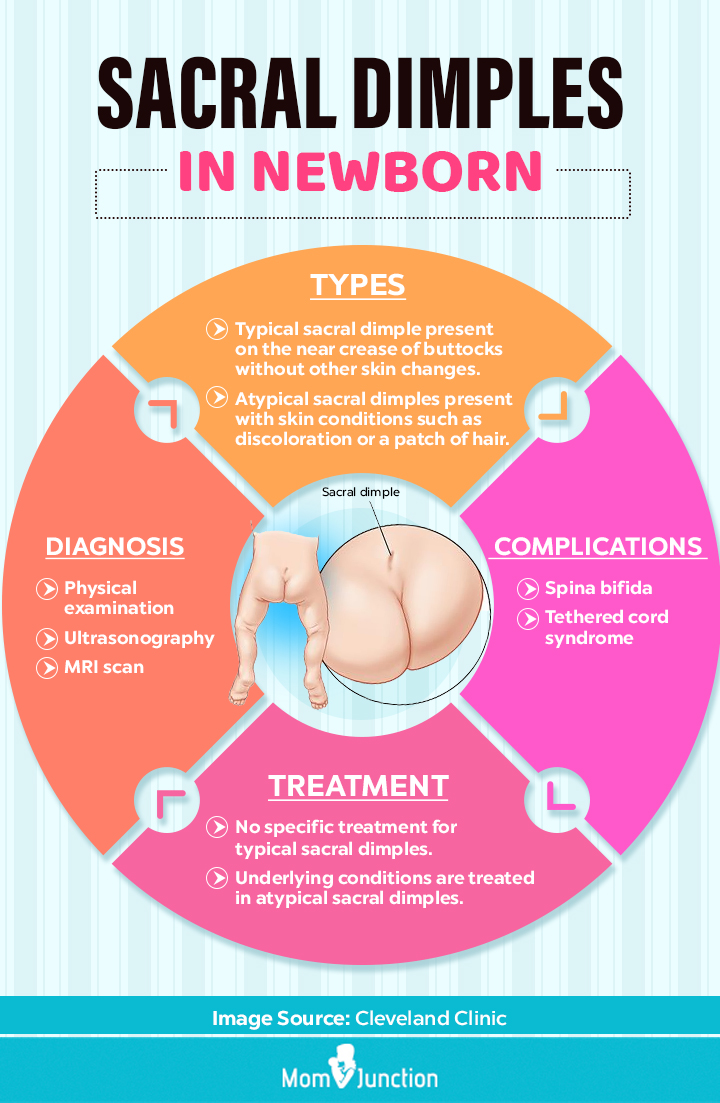
Illustration: Momjunction Design Team
Get high-quality PDF version by clicking below.
Download Infographic
Key Pointers
- Sacral dimples in newborns are a common skin anomaly that has different types.
- Though usually benign, sacral dimples in some cases may indicate an underlying problem.
- Hygiene is crucial to prevent infection of typical sacral dimples, whereas the atypical ones need treatment guided by the pediatrician.
References:
2. Jin Hyuk Choi et al.;Outcome of ultrasonographic imaging in infants with sacral dimple; Korean Journal of Pediatrics (2018).
3.Sacral Dimple: What You Need to Know; Massachusetts General Hospital
4. Sacral Dimples or Pits;Child and Adolescent Health Service Neonatology; Government of Western Australia Child and Adolescent Health Service
5.Sacral dimple; NCH Healthcare System
6.Sacral Dimple; Cleveland Clinic
7.Sacral dimple; Radiopedia
8.Living with Spina Bifida: Infants; CDC
9.Pediatric Spinal Ultrasound; Swedish Medical Imaging








